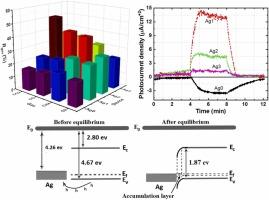从p型电导率到n型电导率:Ag/ pb掺杂SnS纳米复合材料的CO₂传感和光电子性能增强
IF 6.3
2区 材料科学
Q2 CHEMISTRY, PHYSICAL
引用次数: 0
摘要
本文研究了银/铅掺杂SnS纳米复合材料的合成和表征,用于光电和CO₂传感。采用声化学方法合成了不同浓度Ag (Ag1, Ag2, Ag3)和6% Pb掺杂的纳米复合材料,然后进行了结构,形态和光电分析。光学性质表明,银的掺入减小了能带隙,增强了光致发光强度和缺陷发射,从而改善了电荷输运和光电流的产生。电学和光电子性质的研究表明,随着银浓度的增加,电导率从p型转变为n型。气敏测量表明,在200 ppm和180°C下,Ag/ pb掺杂样品的CO₂检测性能增强,其中Ag2样品表现出最佳响应。传感能力的提高是由于表面面积和缺陷密度的增加,从而增加了气体吸附位点和电荷转移效率。该论文表明,Ag/ pb掺杂的SnS纳米复合材料在光电器件和气体传感器方面具有前景,具有在工业和环境应用中检测CO₂的潜力。本文章由计算机程序翻译,如有差异,请以英文原文为准。

From p- to n-type conductivity: Enhanced CO₂ sensing and optoelectronic properties of Ag/Pb-doped SnS nanocomposites
The present research investigates the synthesis and characterization of Ag/Pb-doped SnS nanocomposites for optoelectronic and CO₂ sensing applications. The nanocomposites were synthesized using a sonochemical method with varying Ag concentrations (Ag1, Ag2, Ag3) and 6 % Pb doping, followed by structural, morphological, and optoelectronic analyses. Optical properties revealed a decrease in the energy band gap with Ag incorporation, enhancing photoluminescence (PL) intensity and defect emissions, which can improve charge transport and photocurrent generation. The study of electrical and optoelectronic properties shows a change in electrical conductivity from p- to n-type with the addition of Ag concentrations. Gas sensing measurements demonstrated enhanced performance of Ag/Pb-doped samples for CO₂ detection at 200 ppm and 180 °C, with the Ag2 sample exhibiting the best response. The improved sensing capabilities are attributed to the enhanced surface area and defect density, which increased gas adsorption sites and charge transfer efficiency. This study suggests that Ag/Pb-doped SnS nanocomposites are promising for optoelectronic devices and gas sensors, with the potential to detect CO₂ in industrial and environmental applications.
求助全文
通过发布文献求助,成功后即可免费获取论文全文。
去求助
来源期刊

Journal of Alloys and Compounds
工程技术-材料科学:综合
CiteScore
11.10
自引率
14.50%
发文量
5146
审稿时长
67 days
期刊介绍:
The Journal of Alloys and Compounds is intended to serve as an international medium for the publication of work on solid materials comprising compounds as well as alloys. Its great strength lies in the diversity of discipline which it encompasses, drawing together results from materials science, solid-state chemistry and physics.
 求助内容:
求助内容: 应助结果提醒方式:
应助结果提醒方式:


